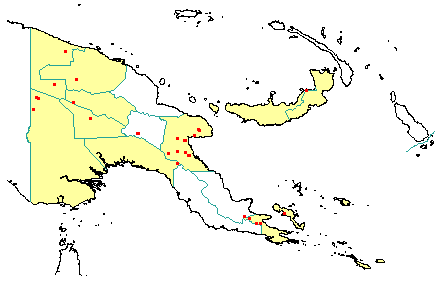
in PNGplants database
PNGTreesKey – Kania eugenioides Schltr. |
Barry Conn (NSW) & Kipiro Damas (LAE).
Guide to trees of Papua New Guinea
Copyright held by the authors, National Herbarium of New South Wales, and Papua New Guinea National Herbarium
Botanische Jahrbucher für Systematik, Pflanzengeschichte und Pflanzengeographie Vol. 52: 120 (1914)
Family: Myrtaceae
Dicotyledon
Timber Group: Non-timber species
Field Characters: Small sub-canopy tree (up to 20 m high) or Large canopy tree (up to 30 m high); Bole cylindrical (up to c. 38 cm diam.); straight (bole up to c. 5 m long); buttresses buttresses absent; spines spines absent; aerial roots aerial roots absent; stilt roots stilt roots absent; Bark red, brown, grey, or white, slightly rough or smooth, finely fissured; Subrhytidome (under-bark) brown; less than 25 mm thick, 5.0-7.0; bark blaze consisting of one layer; faintly to non-aromatic; outer blaze brown or red, markings absent; inner blaze brown or red, markings absent; bark exudate (sap) present, yellow (pale (straw-coloured), not readily flowing (spotty), colour not changing on exposure to air, not sticky; terminal buds not enclosed by leaves.
Indumentum: Complex hairs absent; stinging hairs absent; mature twig indumentum (hairs) soon absent or present when young, hairs dense to sparse.
Leaves: Leaves spaced along branches, opposite (in pairs, opposite one another on the branchlet), simple (a leaf composed of a single blade); petiole present (short), not winged, attached to base of leaf blade, not swollen; leaves broadest at or near middle or slightly broadest below middle, (3.0-) 6.0-12.0 cm, 1.2-2.5 (-3.0) cm; symmetric, entire, not dissected or lobed, acuminate or long-tapering, venation pinnate, secondary veins open, not prominent, but visible, intramarginal veins absent; leaves lower surface green, upper surface dark green (glossy), indumentum (hairs) absent; present; domatia absent; stipules absent.
Flowers: Inflorescence axillary (mostly in distal leaf axils), flowers on a branched axis, cones absent; flowers bisexual, stalked, flowers with many planes of symmetry, 4.0-6.0 mm long, diameter small (up to10 mm diam.) (4-5 mm diam.); perianth present, with distinct sepals and petals whorls, inner perianth bright yellow; 5, free; stamens 12-20, present (anthers with elongated connectives almost as long as anther locules), free of each other, free of the perianth; ovary partly inferior, carpels joined (when more than one), locules 3; styles solitary, 1.
Fruits: Infrutescence arranged on branched axis, fruit 3.0-3.5 mm long, 3.0 (c.) mm diam., brown, not spiny, non-fleshy, simple, dehiscent, capsule (strongly exserted beyond rim of hypanthium); seeds 5-10, to about 5 mm long (c. 2.5 mm long), not winged, narrow (longer than wide), seed less than 1 mm diam.
Distribution: West Sepik, East Sepik, Morobe, Western Highlands, Southern Highlands, Western, Gulf, Milne Bay, Papuan Islands & New Britain.
 | Botanical records in PNGplants database |
Notes: Notes This species was transferred to Metrosideros eugenioides (Schltr.) Steenis by C.G.G.J. van Steenis in Blumea 16: 358 (1969). However, the genus Kania is regarded as distinct from Metrosideros (refer: Peter G. Wilson in Blumea 28: 177 (1982).